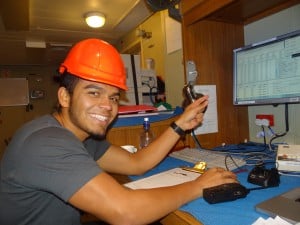
Marvin Alfaro, 2011-2012, Australia, operates a conductivity, temperature and depth measuring instrument on board the Aurora Australis in the Southern Ocean
In honor of World Oceans Day, we are re-posting Fulbright Alumni Ambassador and alumnus Marvin Alfaro’s article describing his Fulbright research studying the Antarctic Polar Front and Global Climate Change: Impacts and Implications. Are you a current Fulbrighter studying oceanography and/or related fields and want to share your story? We’d love to hear from you! Contact us here.
Australia is perfectly situated on the planet for me to pursue my atmosphere-ocean interaction studies. As an undergraduate meteorology major with a special interest in the Southern Ocean, I worked with oceanographers on projects analyzing the strength and location of ocean currents using remote sensing capabilities from satellites. After graduating, I became interested in combining the remote sensing data from satellites with high-resolution data retrieved on board a nautical research trip into the Southern Ocean. The Fulbright U.S. Student Program provided just the type of opportunity I needed to pursue this unique cultural and research experience.
Initially, I expected life in Australia to be very similar to the culture and lifestyle I knew in the United States. But as a Latino and native New Yorker, I was in for a big surprise.
As a Fulbright Student, I lived with and learned from locals, allowing me to see the world through an Australian’s southern-Pacific lens. My Fulbright lasted a year, but the learning will last forever. In Australia, I realized how important Latin American cultures and cuisine are in my everyday life in the United States. Sydney is largely influenced by Asian cultures—Latin American influence is minimal. Before I arrived, I thought of surfers, beautiful beaches, and Sydney’s famous Harbor Bridge and Opera House. They were wonderful parts of my experience, but the Fulbright Program allowed me to experience everyday Australian life, not just see Australian landmarks.
I lived with an Australian family in Hobart, Tasmania, promoted awareness on how climate change and sea-level rise is damaging Australia’s neighboring low-lying pacific islands’ vulnerable coasts, and learned heaps about Australia’s LGBTQ community struggles and accomplishments. Then, in January 2012, I departed Australia on board an Australian marine science research voyage for a six-week journey. Destination: Antarctica.
I set off from Hobart as part of the Conductivity, Temperature, Density (CTD) team on board the icebreaker, the Aurora Australis, with Australian scientists. We were bound for Commonwealth Bay, Antarctica with a final destination of Fremantle, Australia. Our primary focus was to study the waters immediately surrounding the continent of Antarctica as well as a cross-section of the Southern Ocean. Our other focus was historical, which made this Antarctic voyage particularly special. One hundred and one years ago, a party led by Douglas Mawson, set up a base and built huts in Antarctica which still stand today at Commonwealth Bay. Through this visit, we commemorated the centenary of an enterprise that began Australia’s engagement with Antarctica, which is still very active today.
You have to apply for a Fulbright grant to a country, not a continent. But the possibilities with Fulbright are extraordinary. The Fulbright application requires a lot of work, but there are plenty of ways to get all the help you need. A previous research adviser at my undergraduate institution helped me connect with a faculty member at the University of New South Wales in Sydney for my Fulbright affiliation. The most difficult part of the application process was articulating my Statement of Grant Purpose in such a way that anyone reading it could understand the importance, feasibility, and specific goals of my project. One of the Fulbright Alumni Ambassadors, Tiffany Joseph, was my most unexpected resource while applying to the Fulbright Program. And now that I’ve completed my Fulbright year, I have access to a new network of world-renowned oceanographers in Australia and across the globe as I further my career.
My advice to applicants:
1. Explore your academic interests and come up with a vision for a research proposal in your ideal field of study.
2. Seek counsel from your professors and advisers to hammer out the details, contact the Fulbright Program Adviser at your university or alma mater, and begin the application as early as possible.
3. Above all else, be flexible and open-minded. The Fulbright Program is rich with life-changing opportunities if you open yourself up to them.
Have questions for Marvin? He can be contacted as a Fulbright Alumni Ambassador at MAlfaro.AlumniAmbassador@fulbrightmail.org.

No Comments